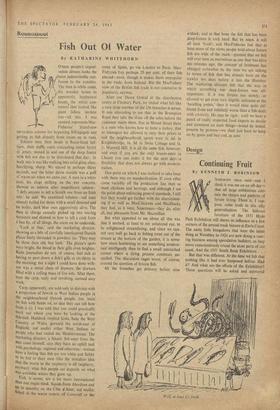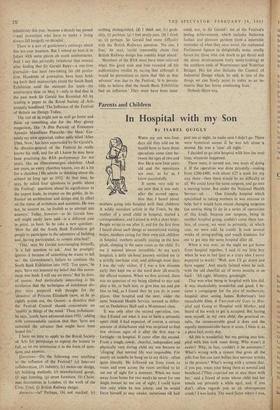Design
Continuing Fruit
By KENNETH J. ROBINSON
But that was different. At the time we felt that nothing like it had ever happened before. Had it? And what are the effects of the Exhibition? Those questions will be asked and answered relentlessly this year, because a decade has passed —and journalists who have to rpake a living always fall hungrily on decades: There is a sort of gentleman's embargo about this ten-year business. But I Intend to beat it in future with some pieces on ninth anniversaries.
And 1 say this advisedly (whatever that means) after finding that Sir Gerald Barry—a one-time journalist—has been two-timing his old profes- sion. Hundreds of journalists have been hold- ing back their manuscripts about the South Bank Exhibitidn until the moment for truth—the anniversary date on May I—only to find that in the past week Sir Gerald has -Revealed All hy reading a paper to the Royal Society of Arts snappily headlined 'The Influence of the Festival of Britain on Design Today.
The rest of us might just as well go home and think up something else for the May glossy magazines, like 'A Pen Portrait of Francesco Antonio Mamiliano Pistocchi--the Man.' Cer- tainly my own appraisal, rather aptly titled 'After Then, Now,' has been superseded by Sir Gerald's. As director-general of the Festival he really knows his stuff, and for all I know he may have been practising his RSA performance for ten years, like an Oberammergau choirboy. (And ten yeais, as every choirboy knows, can do a lot for a choirboy.) He admits to thinking about the subject as long ago as 1952. At that time, he says, he asked four questions in public 'about the Festival: questions about its significance to the export trade, its impact on the public, its in- fluence on architecture and design and its effect on the status of architects and, scientists. He was not, he assures us, `so foolish as to attempt any answers.' Today, however—as Sir Gerald him- self might easily have said—is a different case in point, to boot. So he asks a new question: `How far did the South Bank Exhibition get people to participate in the adventure of building and, having participated, to remain attached?'
`That,' says Sir Gerald (encouraging himself), 'is a fair question to ask.' And he promptly ignores it because of something he wants to tell us: the Government's failure to continue the South Bank Exhibition into 1952. 'Ten years,' he says, 'have not lessened my belief that this assess- ment was bosh. I will say no more.' But he does, of course. And particularly interesting is his revelation that the techniques of exhibition dis- play were prepared with thought for the 'directive' of Princess Elizabeth (now, as he so rightly points out, the Queen)—a directive that the Festival Council should concentrate on 'quality in things of the mind.' These techniques, he says, 'surely have advanced since 1951,' adding with commendable caution that they 'have not sustained the advance that might have been hoped for.'
I have no time to apply to the ,Royal Society of Arts for permission to reprint the lecture in . full, so let me summarise it in the form of ques- tions and answers.
Questions.—Do the following owe anything to the influence of the Festival? (a) Inter-art collaboration, (h) industry, (c) motor-car design, (d) building methods, (e) manufactured goods, (f) sign lettering, (g) street furniture, (h) Christ- mas decorations in London, (i) the work of the Civic Trust, (j) British Railway design.
Answers.—(a) Perhaps, (h) not marked, (c) nothing distinguished, (d) I think not, (e) prob- ably, (f) perhaps, (g) I feel pretty pure, (h) I think so, (i) perhaps. Sir Gerald had more difficulty with the British Railways question. 'No one, I fear; he says, 'could reasonably claim that British Railway design has notably leapt ahead.'
Members of the RSA must have been relieved when this good man and true rounded off his authoritative verdict by saying that although it would be pretentious to claim that `this or that advance' was due to the Festival, 'it is permis- sible to believe that the South Bank Exhibition had an influence.' They must have been inter- ested, too, in Sir Gerald's list of the Festival's lasting achievements, which includes Battersea funfair and pleasure gardens (now a miserable reminder of what they once were), the replanned Parliament Square (a delightfully noisy, smelly haven for those who risk death to get there) and the street developments (very seedy-looking) at the southern ends of Westminster and Waterloo Bridges. His list also includes the Council of Industrial Design which, he said, is 'one of the things we can firmly point to today as an in- itiative that has borne continuing fruit.'
Nobody threw any,







































 Previous page
Previous page